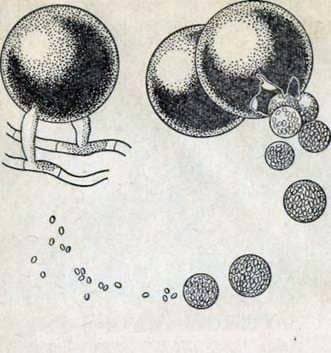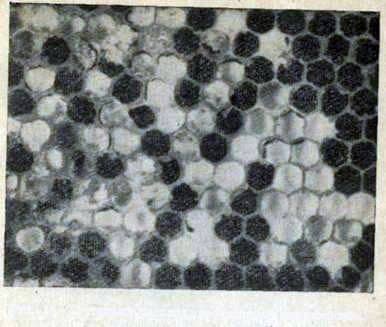
Ascosferosis (pericystomycosis, pericystosis, calcareous brood) is an infectious disease of bee colonies, causing the death of adult drone and bee larvae, their drying into white, like chalk, lumps.
The causative agent is Ascosphaera apis (a synonym for Pericystis apis) – a marsupial fungus from the family of ascospheric, with sexual dimorphism. Forms spherical sporocysts, or spore balls, about 66 microns in size (another species of 128 microns), covered with a thin shell.

Fig. 17. The causative agent of ascosferosis of bees.
Related mushroom Ascosphaera alvei affects the perva. The diameter of its spore balls is about 30 microns. Inside them, oval vitreous-transparent spores of 2×3 microns are formed (for another species 4×5 microns).
The fungus grows on potato-glucose agar with the addition of 0.4% yeast extract, malt agar, Bailey medium. The growth optimum is 30 њ (minimum 22 њ, maximum 36 њ).
On the agar, a dense grayish white mycelium forms from air deep and surface hyphae, their thickness is 4-8 microns, after the union of the male and female mycelium, ascogenous rudiments in the form of blisters are formed at the confluence site, which grow toward the male hyphae. In places of contact with them, an ascendant system is formed, consisting of a central rapidly growing nutriocyte (nutrient part) and a terminal trichogin (stem-shaped part) separated by a septum.
Trichogin enters into contact with the male papilla, after which the protoplasm and the nucleus from the trichogin pass into the growing nutriocyte, forming the asogenic hyphae. Breeding, they form spore asses, each of which contains 8 spores. Their shells dissolve, and spore balls with mature spores are created. They can remain in the nests for decades.
Ascosphere fungus is pathogenic for 3-4-day-old larvae. Spores of the fungus, getting into their intestines, develop well in conditions of low temperature. The most common is the drone brood located on the outskirts of the nest.
Epizootic data. The source of the disease is sick and dead larvae. On the body of one larva, about 108 fungal spores are formed. The disease is spread by adult bees, infecting the feeder with the disease.
The course and symptoms of the disease. Affected more often by weak families, and in them the drone larvae located in the lower parts of the honeycomb. Ill also larvae of worker bees. Protruding into the lumen of the cell, the head end of unsealed diseased larvae is covered with white mold. When the cells are sealed, the white mold grows through the caps of the cells. The dead larvae dry up and harden.

Fig. 18. The drone brood, struck by ascosphere.
At the rear end of the dead larva, the mold takes on the appearance of a gray cap.
Prevention. The maintenance of strong families, good warming.
Control measures. Removal of the affected brood, reduction of nests, warming of families. Weak families connect.
Рамки с восковой молью. В пчелином улье нет матки.
Diseases of bees